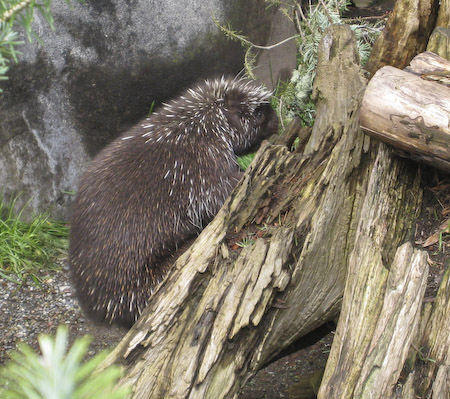The animal is PORCUPINE.
The tree is AMERICAN BEECH.

Congratulations to everyone, actually, for
not giving up on this one, this was an extra difficult quiz!
The beech tree, an eastern tree that might not be familiar to folks
out west, is identified by its smooth light-gray bark, which is an
excellent substrate for showing claw marks. Beech nuts are an important
food source for certain animals in this region, so that is how you go
about identifying the animal that made the tracks.
Most notably, beech nuts are the favored food of bears, but these
tracks are much too tiny to be bear. The tracks are also too large for
squirrel. Instead, the tracks are right on for midsize animals such as
porcupine, raccoon, or opossum.
Although porcupines’ favorite food is hemlock, they are known to eat
beech nuts in late summer and also eat beech bark any time of year, and
in this respect they are more closely associated with beech than raccoon
or opossum. I have never seen claw marks from raccoon or opossum on tree
bark – if they did show at all I would not expect them to show as
cleanly as porcupines, which have much sharper claws. Anyone who has
access to "Mammal Tracks & Sign" by Mark Elbroch, there is a whole
chapter on "Signs on Vegetation", and a comparison of porcupine versus
bear claw marks are shown on pp 613-614. Why the claw marks in this quiz
appear in "pairs" (rather than groups of 4 or 5) is a mystery to me, and
made the quiz extra difficult.
Now, going back to Bear. If a very young cub (on the order of size of
a porcupine) climbed a beech tree it would probably leave tracks
something similar to these. However, such a young, inexperienced cub
would probably have difficulty climbing a smooth-barked tree like a
beech, and if needed for safety and provided with a choice of trees, it
would more likely tend to choose to climb a big old tree with rough bark
and prominent, ladder-like branches if available. Note this tree has
been climbed many times – that means it is for food, not just a one-time
climb for safety. By late summer when beeches start producing beech
nuts, a cub would be much larger than a porcupine and would leave larger
claw marks than shown in the quiz.
The tracks shown in this quiz are a number of years old, as evidenced
by the black scarring of the wounds in the bark, so the time of year was
not a useful clue in this quiz.
Special thanks to Sue Morse of
www.KeepingTrackInc.org for
the opportunity to see these tracks. Keeping Track is a nonprofit
organization whose mission is to inspire community participation in the
long-term stewardship of wildlife habitat. They teach groups of citizens
in the skills of tracking to establish wildlife monitoring programs in
their communities for use in local and regional conservation planning,
and Sue is one of the finest tracking instructors you can find anywhere.
From her, I have learned a great deal about how learning & paying
attention to your TREES helps you to become a better TRACKER. Because
the animals sure know their trees! |